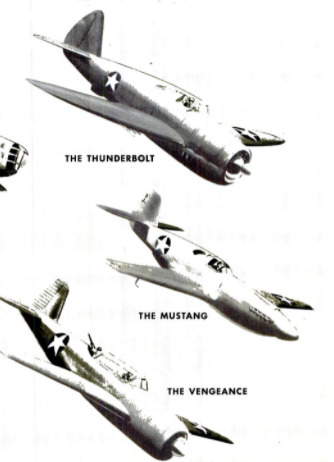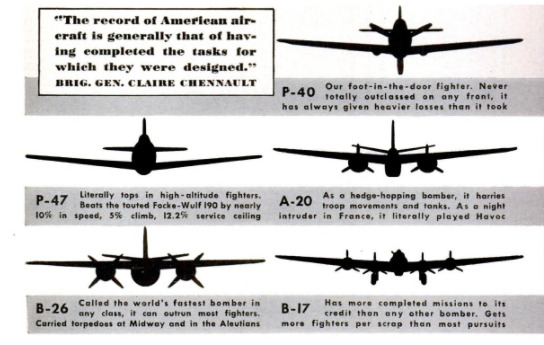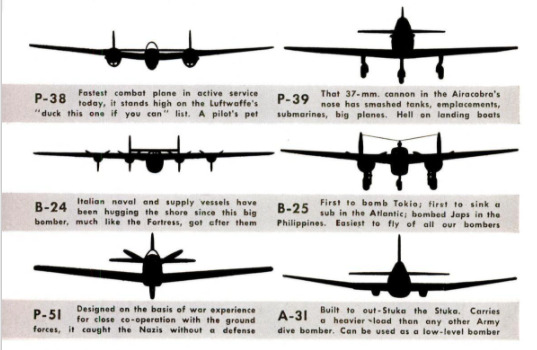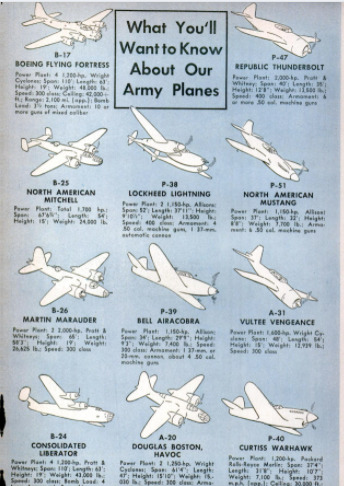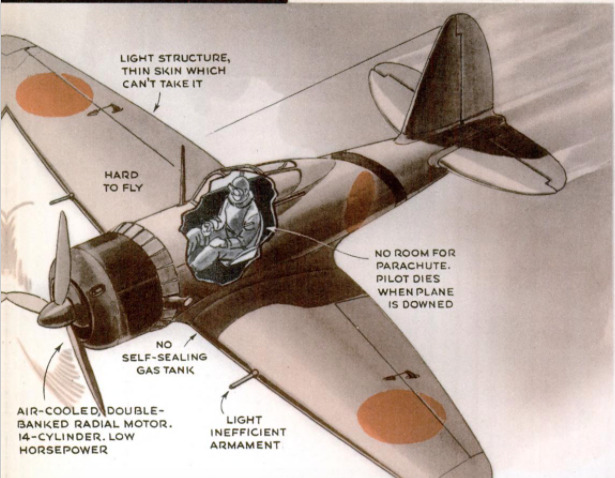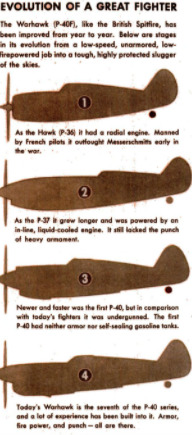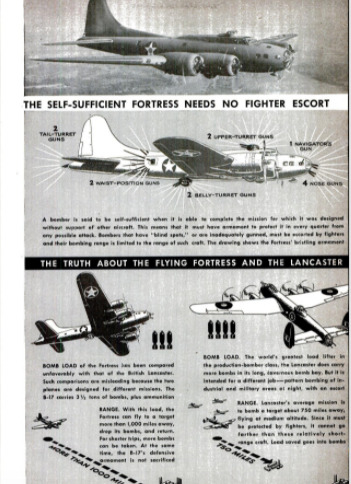-
Title (Dublin Core)
-
How our army planes are to be judged
-
Article Title and/or Image Caption (Dublin Core)
-
Title: The wings of victory
-
Subtitle: This is the yardstick against which our army planes are to be judged
-
extracted text (Extract Text)
-
RMCHAIR AVIATORS, high-altitude ra-
dio commentators, and literary strate-
gists have, in the last few months, managed
to throw the public mind into a dither of
doubt as to the value of our military air-
craft. Their chief weapon has been compari-
son—the quotation of figures which have
made some of our planes appear third-rate.
‘The public, untrained to weigh evidence in
this highly technical field, has been given the
wholly unwarranted impression that Uncle
Sam is sending his air crews out to meet
the enemy in inferior ships.
The industry producing aircraft has been
too busy to refute these comments; the
ARMCHAIR AVIATORS, high-altitude ra-
dio commentators, and literary strate-
gists have, in the last few months, managed
to throw the public mind into a dither of
doubt as to the value of our military air-
craft. Their chief weapon has been compari-
son—the quotation of figures which have
made some of our planes appear third-rate.
The public, untrained to weigh evidence in
this highly technical field, has been given the
wholly unwarranted impression that Uncle
Sam is sending his air crews out to meet
the enemy in inferior ships.
The industry producing aircraft has been
too busy to refute these comments; the
Army has rightly declined to reply to them.
Both prefer to allow the military record
of the nation’s aircraft to make its own
answer. Unfortunately, however, the very
information which would vindicate our mili-
tary seers, designers, and builders happens
to be of highly confidential nature. For the
time being it is more valuable to the enemy
than it is in the hands of the average lay-
man. Perhaps it would be better to present
the average citizen with his own yardstick
against which he can measure the success
or failure of the aircraft that are being
produced for his protection.
The fate of the world is being decided in
the field of military conflict. The outcome
of this conflict is, in a large measure, being
decided by air power. The success of an air
arm depends upon how well its aircraft are
fitted to perform the tasks set for them by
the pattern the conflict has taken. This fit-
ness depends on how shrewdly our military
planners guessed many months before.
In a large measure, the Axis has lost a
phase of this war, despite a measure of ter-
ritorial success, owing to what was prob-
ably the worst guess in history.
The Luftwaffe, originally, was a short-
range army co-operation machine geared
to act as artillery over a front 50 to 150
miles deep. It rolled over Poland like a tidal
wave. If it had kept going, it might have
caught Russia with its air-power down.
Instead, the tidal wave turned and swept
over an aeronautically unprepared France.
At the end of this collapse, the Luftwaffe
ran into the first correct guess on the side
of the United Nations—the Hawker Hurri-
canes and the Supermarine Spitfires.
In 1935, Sir Hugh Dowding, Chief Air
Marshal, called for open bids on a fast,
rocket-climbing, eight-gun ship, capable of
outspeeding and outmaneuvering anything
on wings. Its rate of fire would make it
poison to anything capable of operating
over a longer range than its own. Virtually
everything was sacrificed for speed, climb,
and maneuverability and fire power. At the
evacuation of Dunkirk and the bitter battle
for Britain, the Luftwaffe measured up to
the specifically ordered job only eight
inches to the R.A.F.'s 12 on the ultimate
scale of comparison. Swarms of aircraft
invaded the island, only to be driven off.
The early Junkers JU-87, the Dornier DO-17
and other models that carried the brunt of
the early blitz were short-range aircraft.
Their mechanical advantages had to be
pared considerably to get them over Eng-
land and the thousands of wrecked aircraft
that littered the English countryside were
evidence of the stupidity of the move. Goer-
ing had, in the homely words of the late
“Paddy” Finucane, “tried to eat soup with
a knife.”
How good have our guesses been? How
well are we prepared to fight the type of
war that is unfolding, with equipment that
had to be planned two or more years ago?
Ten or possibly 11 United States types
now in production will carry the weight of
our part in the current conflict.
Probably the most discussed and
maligned of our types has been the
Curtiss P-40. This ship has, at times,
been called the worst and the best
guess of the entire war. Its design
was laid down when no one knew
quite what the war was going to turn
out to be. The type has undergone
seven alterations and modifications,
each one a distinct improvement. It
evolved as the work horse among
United Nations single-seaters.
Tactically, it is an advance-guard
airplane. It is assigned to new opera-
tions where all-around performance
is needed plus the ability to “take it.”
P-40’s have been active in every Unit-
ed Nations front in this war where
land-based aircraft have operated.
They are selected because they are
tough and can be thrown against any-
thing the enemy has. Even if they
are outperformed, they are “beefy”
enough structurally to “duck for home,”
bringing with them what special infor-
mation is necessary to dictate the spe-
cialized aircraft or action needed to re-
place them. They are easy to maintain.
Simple, rugged design and structure
have produced an airplane that is easy
to service and repair. Major structural
replacements, needed only when the
ship is badly battered, can be accom-
plished with the most elementary tools.
The airframe requires virtually no at-
tention. It is sealed and bonded against
the ravages of sand, snow, and tropical
rain. They can be staked outdoors for
months on end. A mechanic who serv-
iced the type in the Philippines, where
airplanes are known to disintegrate
outdoors, said that all the P-40 needed
was gas, oil, and a few kind words and
it would keep running forever.
Justification for the type need only
be read in the final box score wherever
the P-40 went. In the Philippines, a
handful of them cost Japan over five ships
for each P-40 in combat. Here they acted
as fighters, scouts, photo ships, and even
bombers. During the last days on Bataan,
MacArthur's mechanics stuck four P-40s
together out of wrecks and spare parts,
rigged them as bombers, and sent them out
to sink 30,000 tons of shipping in Subic Bay.
In China, their score was 3.9 to one, in
Australia, 3.1. In Russia they were the only
craft capable of clearing the way for the
Stormoviks, while in the Libyan desert they
tackled tanks and bombed troop emplace-
ments. Wherever the task assigned to it
paralleled the original purpose of the fight-
er, the U. S. defense problem, it made every-
thing else it encountered look ridiculous.
The war in the desert belonged to U.S.
types, for at those distances and under
those conditions they were at home.
Probably the prize dumb comparison in
this war is that of the former naval pilot
who compared the P-40 with the Jap Zero.
The over-all box score should have told the
story—3.52 Japanese lost for every P-40.
In turn and rate of climb, certainly the Zero
had an ample edge, but it paid plenty for
the privilege. To begin with, the Zero
weighs 4,750 pounds wringing wet. It car-
ries neither armor nor a self-sealing tank.
Its fuselage, from the cockpit back, is cov-
ered in a gauge of dural thinner than any
rolled in the U.S. It had only a fraction
of the number of instruments carried by the
U.S. pilots, the flier wore no parachute,
the general structural factor of safety was
about 2.5 to 1, differing from the 12-to-1
characteristic of our craft. Annodizing, to
protect the ships from ravages of the
weather, is virtually unknown. The Zeros
are frequently unpainted and only a “dim-
mer” coat keeps the sun from making them
a long-range target.
Those who would like our men to fly this
kind of a winged coffin are reminded of one
thing. At the outset of the war, a rumor
was current that the “heroic” Jap pilots
would crash-dive their airplanes rather
than allow them to be captured in examin-
able shape. This was a figment of the im-
agination. The truth of the matter was that
the Zero was so frail, that any mishap in
landing would practically roll the craft up
into a ball.
The Curtiss-Wright Corporation finally |
sank the “magnificent Zero” myth once and |
for all when they stripped thirteen hundred
pounds of weight out of a P-40—spare
guns, self-sealing tanks, Instruments and |
the like. They reduced its armament and |
load to that of the Zero without impairing
the P-40's inherent structural strength.
The experimental airplane, thus stripped,
carrying a 180-pound pilot with his para-
chute—and, toting a wing loading in excess
of the Zero's 20 pound per square foot, out-
climbed, outturned, outmaneuvered and |
outfought the Zero on every one of the 11
basic categories of performance laid down |
by General Chennault and the Flying Tigers
in China. |
The question arises, why are these air--
planes fought carrying these heavy Wing
loads? The answer can be found in the
basic military philosophies of the two na-
tions. To the Japanese, the victory belongs
to some abstract personage and the sol-
dier. His individual existence means noth- |
ing. Providing for a better than even
chance for the pilot is unheard of. Techni-
cal experts who have examined the wreck-
age of the Zero state that its frailty made
simply flying this craft an act of desperate
heroism. Extreme gust acceleration found
under thunderheads or similar meteorologi-
cal conditions have been known to shake
the Zero apart. We as a nation believe that
the victory belongs to the individuals who
make up the nation, the air crews among
them. The victory is of little value to them
if they do not survive to enjoy it. We
choose to enhance our pilots’ chance of sur-
vival by every mechanical means at our dis-
posal, leaving heroism to the individual
choice. We simply do not elect to pay for
that kind of performance with the safety of
our flight crews.
The ultimate justification for our philos-
ophy of sacrificing the edge of performance
for a margin of safety lies in the fact that
Japanese Sentoki 001, the successor to the
Zero, carries self-sealing tanks, heavier
general structure, etc. Despite 300 more
horsepower, it 1s inferior to the original
Zero on climb and turn. While human life
is a small consideration to the Japanese
high command, the number of men lost
through structural weakness of the craft
prompted a change. The Jap Air Staff
guessed wrong—the change admits it.
The next in line for literary back-stab-
Ding is the P-39, the Bell Airacobra. From
its inception, this child of scorn and wiz-
ardry had a lot of people disliking it. The
pilot sat in front of the engine, the power
was delivered in a U line down from the
drive shaft, under the cockpit floor, and up
to the propeller. Here it met the basic as-
sumption of the Alracobra, the 87-mm.
cannon, supported by two synchronized .50
caliber guns and four .30's firing free out-
side the propeller arc. Changes may have
Zero, carries self-sealing tanks, heavier
general structure, etc. Despite 300 more
horsepower, it is inferior to the original
Zero on climb and turn. While human life
is a small consideration to the Japanese
high command, the number of men lost
through structural weakness of the craft
prompted a change. The Jap Air Staff
guessed wrong—the change admits it.
The next in line for literary back-stab-
bing is the P-39, the Bell Airacobra. From
its inception, this child of scorn and wiz-
ardry had a lot of people disliking it. The
pilot sat in front of the engine, the power
was delivered in a U line down from the
drive shaft, under the cockpit floor, and up
to the propeller. Here it met the basic as-
sumption of the Airacobra, the 37-mm.
cannon, supported by two synchronized .50
caliber guns and four .30’s firing free out-
side the propeller arc. Changes may have
been made in the general armament setup,
but the theory of building an airplane be-
hind a gun had proved out. The Airacobra
is murder on anything that gets in front
of it.
The radical idea of putting the engine,
the heaviest single piece of equipment in
the whole airplane, smack on the center of
lift and load was looked at with suspicion
by orthodox designers and air tacticians.
Off-line power delivery looked uncertain,
unreliable, and an invitation to maintenance
trouble. Nevertheless, the guess was that
somewhere an airplane would be needed
that could blast its way into and out of
formations of anything that flies. Larry
Bell started with the idea that the best
place to put an antiaircraft gun was on an
airplane. The most important single ad-
vantage of the P-39 general design is that
the size, rate of fire or shell velocity of the
forward-firing gun can be altered as the
requirements of war change, without major
modification of the type.
The P-38 was our original bid for high-
altitude strength. A radical design, it is
singularly maneuverable for a twin-engined
ship. The basic disadvantage of most twin-
engined fighters is their inability to make
short-radius turns. Having two parallel
lines of thrust and two similar torque al-
lowances to make, the craft must “bend”
two force lines in order to turn. This makes
the banking harder, just as it is more diffi-
cult to turn sharply with a car than it is
with a motorcycle. The Lightning gets
away from this problem in a measure by
turning the propellers in opposite directions.
Thus each engine counters the other's
torque, eliminating dynamic allowances for
this turning tendency such as wing warping,
and off setting the
vertical fins which cut down speed. It also,
in effect, makes the airplane practically
torqueless, therefore, more maneuverable.
Putting the pilot and armament in a sep-
arate nacelle or streamlined pod in the cen-
ter of the wing offers several advantages.
In the first place, the accuracy of fire from
the four .50 caliber machine guns and sin-
gle 37-mm. cannon is enhanced by the fact
that they are mot mounted over or in the
same line with any vibrating power plant.
Grouped as closely together as they are,
the guns’ fire pattern is concentrated over
a small area and has the effect of a combi-
nation meat grinder and buzz saw when it
gets the range for even a short burst. The
small nacelle can be sealed airtight and su-
percharged without the mechanical diffi-
culty encountered in the ordinary full-
fuselage designs. This makes it one of the
top high-altitude jobs of all time.
The P-51 is our latest baby, so good that
even the British have gotten enthusiastic
about it. It is a change-of-pace airplane.
The hell that the U.S.-built Flying For-
tresses have raised in the “out of sight”
fighting levels have forced the Axis to build
such monstrosities as the Focke-Wulf 190,
the new Messerschmitt 210, and the like.
Suddenly the Mustang arrives, capable of
making great speed within a shadow of the
ground. Only the luckiest kind of a shot can
bring one down.
The human ear can pick up the sound
of this low-flying infant only when it is
overhead. One of the forerunners of the
Dieppe raid was said to be a lone P-51 that
picked itself a deep, rolling Channel swell
and, skidding all the way across the Chan-
nel in its trough, hopped over the sea wall,
flew between two buildings, heaved a salvo
of delayed-action bombs into the largest
radio installation on the occupied French
coast, and dashed back before the German
alarm system had a chance to function.
It is a lot harder to get a low-altitude
ship to go fast than one built to operate in
the substratosphere. The thin air in the
higher levels offers little resistance to the
wings, and as long as there is enough sur-
face and enough power, the airplane can
move at quite a clip, simply because there
is little to hold it back.
At the lower levels, while the lifting
characteristic of wings is far more efficient,
the air offers far greater resistance. At
high speeds, it tends to “pile up” just be-
hind the highest point of wing curve, At
speeds approaching 500 m.p.h. on most con-
ventional wing curves, the air actually
breaks its “laminar flow” and lift-destroy-
ing turbulences occur in the boundary layer.
The Mustang is winged with a special air-
foil whose profile permits the smooth flow
of air at all speeds.
Some of the aforementioned critics of
U.S. tactics seized upon the scant early
information on the P-51 to criticize the fact
that it had poor high-altitude performance.
To begin with, the P-51 has no high-altitude
performance--none was built into it. Every
line, provision, and device in the ship was
built for phenomenal speeds at low levels.
An early critic stated that the new German
FW-190 that appeared at about the same
time would probably outrange and outfight
the Mustang if it tried to come up and do
combat at the 190's most efficient level of
22,000 feet.
In the first place, the P-51 would prob.
ably never seek combat with a 100. It is not
built to do that kind of a ob. Secondly, the
P51 could not get to 22,000 feet with any-
ting lesa than & atrato-balloon. Buti
the 190 had the bad judgment to come
down to the lower levels, It would be a
helpless aa a fiah out of water. Consider
the welght side of t. The 100 would be
running around with the welght of an
unused supercharger, oxygen system, the
weight and drag of a thick, high-altitude
Wink, 40 percent of which would be wurplus
at low levels, and its pilot wrapped up in a
toddy-bear sult. 1s engine, geared to pro-
duce ita top power in’ thin air, would be
putting out lows than 60 percent of ita
Power. Compare this flounderer with the
Cocky Kid flying in hin shirt sleeves In a
comfortable low-altitude Job, with only the
thinga he needs urrounding him; his engine
putting out every rev it €an ind n Wing
custom-built to keep him fying at his own
particular level
Ft mate to the Lightning, the P41, Re
publica “Thunderbolt, Is our newest bid for
Bigh-altitude supremacy. Av yet unproved
in’ battle, we have only characteristic com-
parison to check it galnst. Wo know that
type ia needed that can stand and Aght
at high wltitudos, that has range enough to
meet and intercept. high-flying, ov-rango
aircraft, that will have speed and climb to
Spire nnd have one prime virtue missing in |
most high-altitude craft gunpouer. So far, |
10 ship AL any clans or altitude has demon: |
strated the horizontal speed of the Thunder. |
bolt. Ita rato of climb in phenomenal, its |
gunpower burst equal to the Impact of
fve-ton truck at 60 mph. The fact that
tho two Iateat-type fighter crart operate at
opposite levels indicates the Justification of
the former U. 8. theory for the conduct of
war, the change of pace that requires the
enemy to keep a great diversity of equip-
ment in production.
The A Class attack and dive bombers—
are the group that stands between fighters
‘and bombers. We have concentrated on two
such types. The A-20, known as the Douglas
“Boston” in its day-raider conversion and
the Havoc as a night fighter, is basically an
attack bomber. It is bullt to operate at
near pursuit speeds, pack a lot of gun-
power forward and enough maneuverability
to take on any single-seater built, The big
thing that was asked of the A-20 design
was range of speed-— the ability to cruise at
Dear-stalling speed for hours on end, hunt-
ing out troop concentrations, convoys, and
weal spots. Once they are spotted, the
A-20 hauls up its flap, opens the gun, and
punishes the objective with a murderous
fre-cluster forward, baptizes it with bombs
as it goes over, and then dusts it off with
the rear gun as it speeds by.
The Boston's record in daylight sweeps
over the continent is equaled only by the
African record. A thoroughly disorganized,
busted-up troop, supply, or tank movement
is termed Bostonized no matter how the
action happened. The A-20's wide range of
speed and favorable landing characteristics
promoted by an awninglike flap and tri-
cycle landing gear have made the night
version, the Havoc, with double forward-
firing power, ideal for prowling around
German fiying fields in northern France,
wating for some unfortunate bomber to
try to take off. At the precise moment when
the bomber begins to be nir-borne, the
Havoc dives in and gives it a single burst,
frequently causing the ship to explode with
1fe Griiee ctruetive Wad aboard,
The manufacturer's designation for this
type is the DB-7. It is the first one of its
type to be able to out-Stuka the Stuka and
fight anything that came against it.
The other U.S. member of the A class,
other than the Douglas “Dauntless,” which
was borrowed from the Navy as a short-
range stop-gap, is the A-31, the Vultee
Vengeance. Originally programmed for ex-
clusive British production, this design in-
corporates all the virtues of the former
types of single-engined dive bomber, stam-
ina plus good control of diving direction;
and speed, plus enough gun-power for its
own defense.
The original Stuka, the Junkers JU-87 is
an outstanding example of a one-purpose
airplane carried to a great extreme, A
capable dive bomber, it was a dead duck
if caught by anything that could really
fight. The Germans tried to counter this
frank tactical mistake with imitations of
the DB-7—light, twin engined bombers
equipped with diving brakes. While these
were fairly successful, they gave up some
of the essential virtues of the JU-87: eco-
nomical operation, great maneuverability
close to the ground, steep diving angle, and
great variety of dive pattern.
Combining our own U. S. dive-bomber ex-
perience with some of the German ideas
plus the British experiences, the Vengeance
was built. In the first place, the Vengeance
is plentifully armed. Its total gun power is
that of the average single seater. It carries
its bombs internally, permitting at-will
bomb selection and higher speeds. The
average enemy dive bomber carries most of
its missiles externally, and the loads, usu-
ally hung under the wings, must be symmet-
rically released to keep the ship under
good control.
Our two current medium bombers stack
up well against their basic requirements,
and the basic requirements indicate that the
Air Staff were better guessers than average
in this class.
In the B-25, they asked for a medium-
weight bomber that could operate out of
short, unprepared fields under all condi-
tions. It required mid-altitude performance
for middle distances under fire through
hostile country. Therefore, a good part of
the useful load had to be invested in arma-
ment. While the first submarine sinking in
the Atlantic and General Doolittle’s raid on
Tokio may have been spectacular demon-
strations of the B-25's versatility as a com-
bat bomber, General Ralph Royce’s raids on
Japanese emplacements in the Philippines
showed the ship to its best advantage. Slip-
ping into hastily prepared advance bases, so
quickly arranged that the enemy hasn't
found” them yet, Royce punished them
soundly from both low and medium alti-
tudes and was out of range before the yellow
brethren could gather their wits.
This demand for “get up and go” is amply
supplied by the Mitchell, as the type has
been named. In Australia and the Archi-
pelago it has been flown from beaches and
crudely hacked-out fighter-advanced posts.
Its heavy armament allows it to operate
without fighter support and frequently with-
out any advance pursuit co-operation. In
other words, a gang of B-25's is capable of
parking anywhere midway between the
enemy and a supply base and operating as
long as the fuel, ammunition, and supplies
flow in at a tolerable rate.
The Martin Marauder, the B-26, was one
of the most spectacular guesses in air his-
tory. There were some in the Air Force
that would have bet heavy odds that Peyton
Magruder’s overgrown closed-course racer
would wind up a prototype and a number.
Like the bumble bee, one could prove on a
slide rule that it was incapable of taxiing,
much less flying. Magruder, young, lithe,
handsome nonconformist, kicked half of
the accepted theories for bomber construc-
tion out of the window when the Army
asked for a terrifically fast short-range
bomber that could interchange weight for
range at will.
Several basic sketches were presented at
a staff meeting at Martin's. Some were im-
provements on the existing Marylands and
revised Baltimores, others were radical
changes. The most radical was the Ma-
gruder suggestion. Glenn Martin took one
quick look at the B-26 and selected it. Some
wondered if the boss was slipping.
No one, thus far, has doped out a logical
way of attacking the B-26. Hauling nearly
as much armament in a small area as a
heavy bomber, carrying nearly as much
weight as a Fortress (a shorter distance),
most fighter craft would have to work hard
to catch this ship and then might find they
had a bear by the tail. With plenty of guns
forward, top, tail, at its sides, and below,
it resembles the B-17 in the completeness
of its gun-arc coverage.
At Midway and off the Aleutians, they
have been “doubling in brass” as torpedo
planes. The rack for torpedoes has been
built into all existing models. It can serve
interchangeably as heavy-weight, short-
range bomber with its normal tanks; mid-
dle-weight, mid-range bomber with a fair
load; or it can, by installing self-sealing
tanks in as many of its four bomb bays as
needed, haul a bigger torpedo farther than
anything except a submarine or a destroyer.
We can stick our chests out the farthest.
in the long-range bomber class. First, our
B-24, the Consolidated Liberator. Having
the intestinal fortitude to adopt a radical
wing curve is something even Japan's des-
perate ministry dared not do. The Davis
wing that mounts its long, tapered span,
permits greater lift from its area than any
other yet devised. There is a lot that can-
not be said now about this wing, but the
fact that the B-24 is the backbone of our
air-freight system indicates that it is the
hottest long-range hauling machine in the
history of transportation. Like the P-40 it
is a foot-in-the-door airplane. Its tricycle
landing gear allows it to get in and out of
places formerly reserved for light, twin-
engined transports of the 9,000-pound class.
Alongside the Hurricane and the Spitfire,
the B-17 will probably remain among the
greatest tactical guesses in history. The
self-sufficient bomber was a pet dream of
General Arnold for a decade. The original
proposition was to build an airplane that
could strike hard or sink a battleship half
way out in the Atlantic, disperse landing
efforts off the bulge of South America, or
hop off the bastions of Hawaii or the sta-
tions in the Philippines to meet an enemy
fleet anywhere in the Pacific. More impor-
tant, it was determined even then that a
bomber, trying to get to a vital area in the
heart of an enemy country, would have to
fight off wave after wave of attackers.
This meant that its penetration was limited
not by the amount of fuel but by the
defensive ammunition it could carry.
Load-hauling, high-climbing aircraft had
been built before, but this ship had a spe-
cific job to do—precision bombing at long
range at high altitude. It could not afford
to have its radius of action limited by the
range of escort aircraft. It had to proceed
to a distant target alone. The U.S. Army
bombsight would permit spot effectiveness
of bombing, so too much weight was not
necessary. This was no pattern-bombing
craft, satisfied to slip in at night and ob-
literate an area; the global war for which
this was built required that it be able to
hit one ship, one block, or one house from
a height out of range of any attacker.
How has the General Staff guessed ? Look
at the pattern of its result in every theater
of war. To begin with, what other nation’s
equipment is serving wherever fighting is
taking place? Obviously, our equipment is
the only group built to fight a global war.
In each class, two types are represented at
least—one “foot-in-the-door” airplane to es-
tablish advanced bases, feel out the enemy
and establish the pattern of action. The
others are the knockout types, the ships to
come in and deal the telling blows.
Our aircraft have shown up as superior
to any, even those of our allies, in one out-
standing general characteristic stamina.
Those who foresaw a global war knew that
aircraft would have to be dispersed to far
places, transferred from one climate to
another, live outdoors for the duration and
frequently be maintained with the simplest
tools or no tools at all.
These are the 11 main types. We will
“probably see many more added before the
conflict is over. Nevertheless, there are
experts who expect to see only modifica-
tions of these less-than-a-dozen in the fight
when the Axis is finally buried.
-
Contributor (Dublin Core)
-
William S. Friedman (Article Writer)
-
Language (Dublin Core)
-
eng
-
Date Issued (Dublin Core)
-
1943-01
-
pages (Bibliographic Ontology)
-
70-83, 222-227
-
Rights (Dublin Core)
-
Public Domain (Google Digitized)
-
Archived by (Dublin Core)
-
Matteo Ridolfi
-
Marco Bortolami (editor)
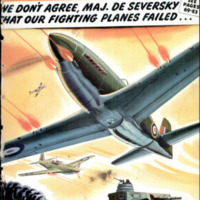 Popular Science Monthly, v. 142, n. 1, 1943
Popular Science Monthly, v. 142, n. 1, 1943

